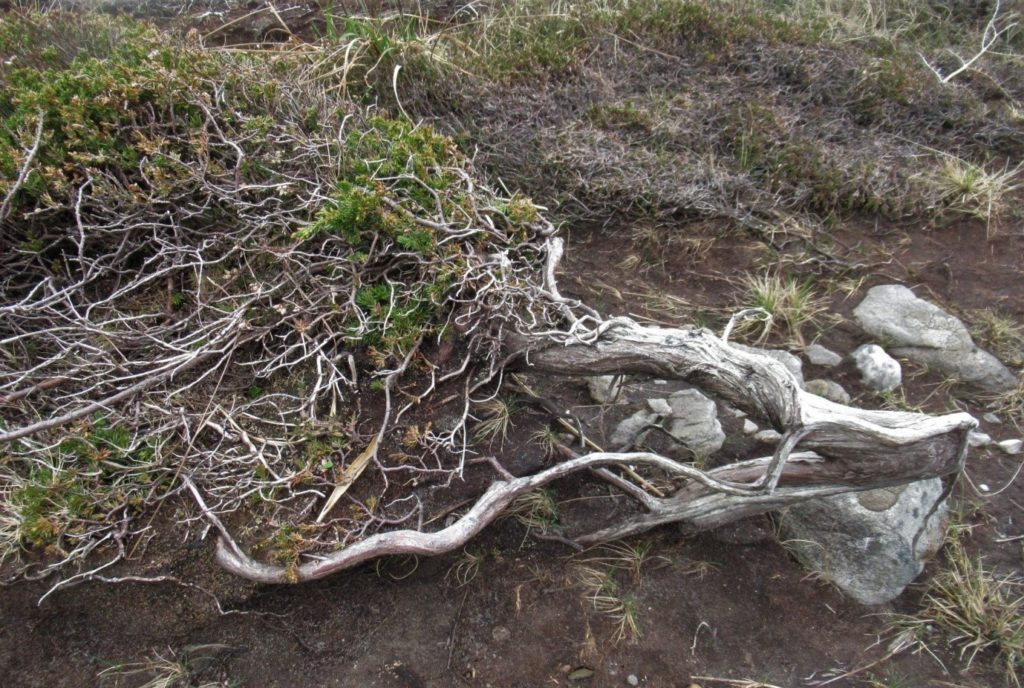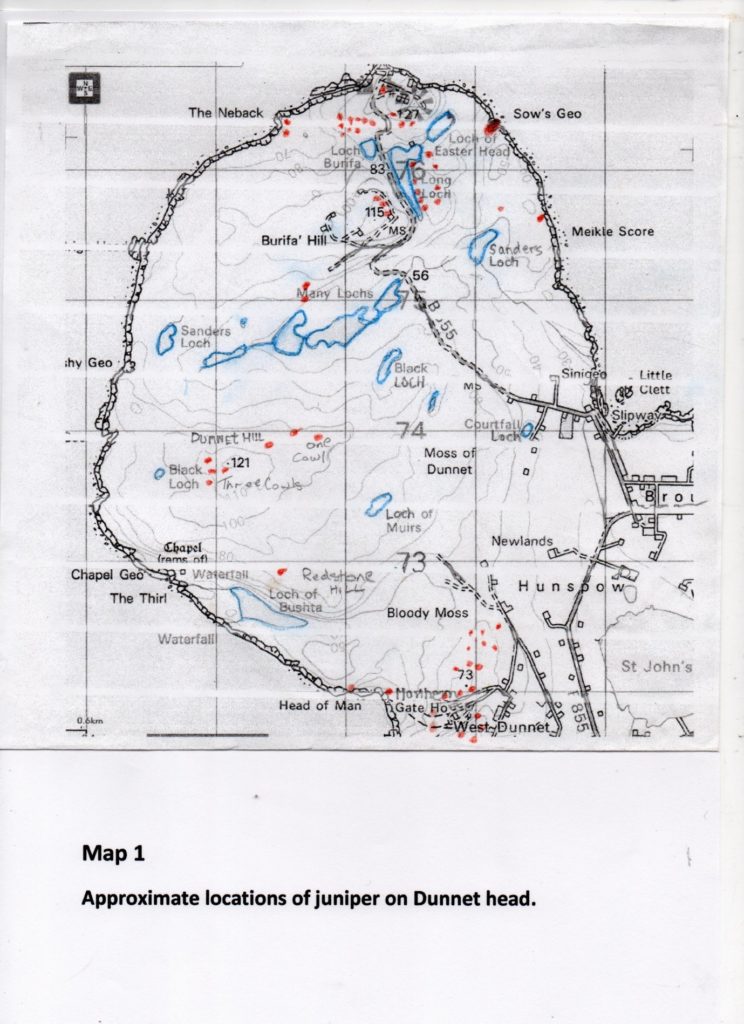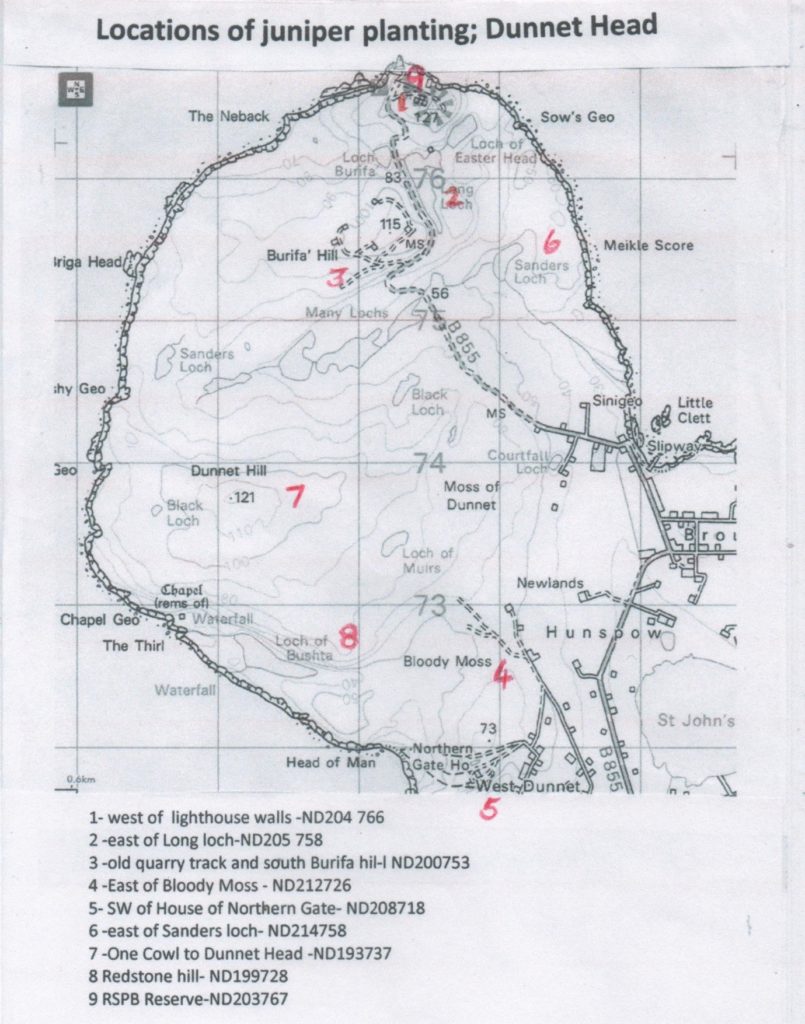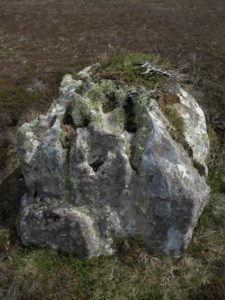Caithness Juniper Restoration Project
The Dunnet Head Juniper Project ; Caithness Biodiversity Group. 2015 -2021
The most northerly populations of juniper on the Scottish mainland are found on Dunnet Head, Caithness. Here exposure to extreme weather and a high latitude produces an almost tundra like landscape of low growing shrubs including creeping and dwarf willow, bearberry, blaeberry, stunted heathers and juniper.
In 2007 the Caithness Field Club were sponsored by Nature Scotland (then SNH) to survey the headland`s juniper populations. This revealed hot spots of good density, where plants appeared to be healthy and able to regenerate in contrast to areas where the habitat appeared suitable for juniper but where only isolated or very old shrubs were found.
There is a history of severe and repeated burning from the 1970s on the headland; the last fire taking place in 2008.
This covered a large section of the western side. It is thought that fire damage resulted in the destruction of juniper over these locations.
Caithness lies in Zone 3 as defined by Forestry Commission Scotland as an area where populations are impoverished and sustained conservation is required. The Caithness Biodiversity Group had been considering the idea of a juniper project to enhance these local populations so it was a well timed conversation with Claire and Martin Murray from the newly established Dunnet Bay Distillers that led to the setting up of a joint initiative with the distillery and the Highland Council (from their Discretionary Fund) leading to the Caithness Biodiversity Juniper Project.
In 2015 the juniper project began. Its main aim was to increase the number of junipers on Dunnet Head especially in those areas damaged by fire or where shrubs were old and isolated.
There were several stages to the project which was seen as being long term in nature.
The stages were as follows
- To research further the location and health of juniper on the headland. Resurveying some of the hotspots and checking out areas not covered by the Field Club`s search.
- To obtain land owner permission to harvest seed and also plant out new juniper.
- To take cuttings, sending some to experienced nurseries for care and propagation and to develop the horticultural skills of the project volunteers in propagating juniper cuttings and caring for them locally.
- To collect local seed and develop the skills of propagating juniper from them.
- To establish a small juniper nursery at Rock Rose Distillery where its role both as a native Caithness shrub and also the history of juniper use in illicit distilling can be interpreted.
- Raise awareness on Caithness juniper populations and the detrimental effect of wildfires on fragile vegetation focusing initially on Dunnet Head. This would be carried out through guided walks (national juniper day.) press releases and social media.
- To plant out successful cuttings and plants grown from seed into the locations where fire has damaged the former populations.
We also hope that the skills developed could be applied to enhance other areas of isolated and struggling juniper populations in Caithness.
In 2015 The Caithness Countryside Volunteers extended the survey work carried out by the field club on the juniper locations on the headland. This gave a fuller picture of the juniper population and its health. Isolated older juniper plants were recorded and areas where the communities were successful were discovered. On a very wet day in June eight volunteers covered three different sections on the headland using GPS to note down new records.
Previous to this some of the old Field Club`s hotspots were rechecked to see if they were still rich in juniper shrubs and they were found to be so.
The first section turned up a small hot spot at ND201764 approx to the north of Loch Burifa.
More records were also found east of long loch where the second group surveyed.
The last area covered was the stretch from north of grassy Loch across to Dunnet hill. Here very few juniper were found.
Map 1 shows approximately the records found. This map also includes other records found during subsequent exploration of the headland. The map highlights the hotspot areas and those where only isolated shrubs were found.
The horticultural skills of the project volunteers in propagating juniper cuttings and caring for them have been developed through training from Highland nurseries, research and experimentation. With these skills we have grown juniper from seed and cuttings at Dunnet Bay Distillery and in the gardens of other Caithness Biodiversity group members. Over the years it was propagation from Dunnet Head seed that became the main method of raising plants as it produced new seedlings and was less destructive than taking cuttings. The raising of healthy juniper takes time as germination is staggered over several years. Small plugs require tending and re potting as they grow.
Some cuttings and seeds (about 1,000) were also sent over to Little Assynt Nursery and grown plants returned firstly from cuttings (2016/17) and then from seed.
Once strong plants had been grown we trialled planting those robust enough out on the headland. We chose for our first sites two that already had some juniper. One was to the west of the lighthouse keepers` walled garden (approx. ND203767) using juniper mostly from Little Assynt Nursery the other was alongside Long loch. Thirty eight in total were planted.
The planting was carried out by volunteers from the Caithness Biodiversity group and the Caithness Countryside volunteers (Groups combined in 2023 to become Caithness Environment Volunteers). GPS readings were taken and juniper were marked using a small cane to make monitoring easier. Planting Location GPS co-ordinates here.
Over the years we tried other sites planting in both May and October/November. The advantage of a May planting is that the weather is kinder on the young plants but dry conditions can be a problem as in the drought of 2018, when young plants had to be watered .These planting sites are marked approximately on the map and can also be seen in the location table. (See Map 2) As the young juniper is in pots and not bare rooted this gives more flexibility in planting times.
The new juniper were monitored annually. A five year monitor would give the best indications of survival so the monitoring needs to be continued for the later plantings.
To date 350 juniper, grown from cuttings and seeds have been planted out on Dunnet head. The young plants have been monitored and approximately 70% have survived so far.
Several conclusions can be drawn from the project;
- Juniper grows best in well drained land and favours a mineral soil. A few isolated plants were found growing in disused peat extraction paths demonstrating a liking for stony, well drained soils. These gritty conditions are also an ideal medium for seed germination. Paths are also useful locations in which to plant as they may be safer from any further fires.
One very old plant was found north of Sanders Loch (ND213756) stretching over a large boulder in an area where very few juniper occur except on the cliff edge or stacks (Sow`s Geo). This isolated plant may have grown from a seed dropped by a bird onto a small pocket of organic material in a rock crack or eroded pothole. (see Image 2 at bottom of this page.)
- Growing juniper from seed is not that difficult but it requires patience. The emerging plants look like tiny twinned needles. Their germination from a given planting will take place over several years. They will then require to be potted on as they grow.
- Seed preparation is the most demanding part of the process and various methods were used to break down the berries, removing the flesh to reveal the seed. These ranged from higher tech systems using sieves and liquidiser to simply chewing or manually removing the flesh usually carried out while watching TV! Seed was then stored in the fridge over the winter months to break dormancy and later planted in a gritty seed compost in spring.
- When planting out vulnerable young plants support was given to them by building shelters from local stone or using a clump of heather as a wind break over the young shrub. The latter appeared to be the most effective of the two giving the juniper some protection from the strong, scorching winds found on the headland
- Growth rate varied with some juniper taking longer in showing growth than others
- Through spending time on Dunnet head it seems that the state of the juniper populations is better than was initially thought with some regeneration taking place
- The main reasons for dying were that the planting site was too wet or too exposed. A combination of the two is usually lethal. Sheep, or rabbit, pulling out freshly planted juniper is another.
The Caithness Biodiversity Group would like to thank Dunnet Bay Distillers and the Highland Council for their funding, Little Assynt Nursery and Poyntzfield Herb Nursery for their training and growing young juniper from our seed, the members of Caithness Countryside Volunteers and the Caithness Biodiversity Group for surveying, juniper production and planting out. Thanks must also go to the Land owners on Dunnet Head for permission for survey and planting.
Most of the Dunnet head planting is now complete. Hopefully the new juniper growing around the isolated shrubs at One cowl Two, Cowl, Dunnet Hill, Redstone Hill and the old quarry will develop into viable communities.
This report was written by Mary Legg. Caithness Biodiversity Group 2021.


Map 2 – Location Numbers
